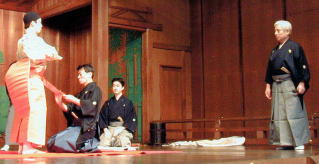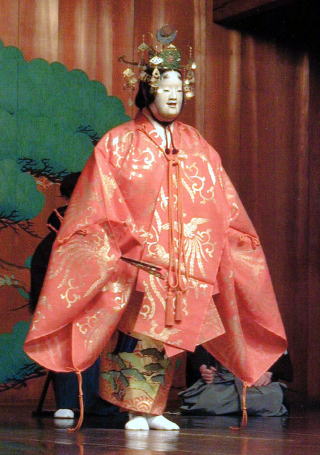Meguro UNESCO Short News

On February 23, 2002 “UNESCO Noh Theater” was held at the 14th Kita
Roppeita Kinen Nohgakudo, sponsored by the Meguro Board of Education and
presented by the Meguro UNESCO Association. It was the 14th annual event
of the Meguro City International Exchange Forum that has so far introduced
various Japanese cultures such as Noh, Gagaku (court music), Kyogen (a
farce presented between Noh plays), Sankyoku (a three-part piece for a
koto, a samisen, and a shakuhachi), Bunraku (a puppet play), Budou (martial
arts), Kabuki, etc. Every year we were able to carry out our program successfully
thanks to the generous cooperation of the Meguro Board of Education and
the performers who kindly participated, and now we think we must make special
mention of the kindness and consideration of the Kita School, who offered
us their Noh theater, the 14th Kita Roppeita Kinen Nohgakudo, as the venue
of our event and had some members including two leaders of the school exhibit
their performances. Interpretation and English explanation by Mark Oshima,
who has now become a regular participant, was well received by the foreign
audience. We'd like to express our heartfelt gratitude to all the people
who helped us in this event
1st Part - Introduction to Noh Costume
Explanation: Kouji Takabayashi, Kita School, bearer of the title “Important
Intangible Cultural Property” (far right in the photo above)
Interpretation: Mark Oshima
 2nd Part - “HAGOROMO” (The Robe of Feathers)
2nd Part - “HAGOROMO” (The Robe of Feathers)
SHITE (main character) an angel: Akio Shiotsu, bearer of the title “Important
Intangible Cultural Property” (photo left)
WAKI (supporting character) a fisherman: Yoshihiro Tateda
For the February issue of “Short News” Mr. Shiotsu contributed to us
a valuable article “Join us with Your Determined Will to See”. The following
article was also contributed after the event. We are deeply grateful to
the members of the Kita school.
The 14th Kita Roppeita Kinen Nohgakudo
By Hiroyoshi Serizawa
In a book about historical events in China there is a phrase “picking
simultaneous with peeping”. When an egg is going to hatch, the chick
peeps trying desperately to tell us that it wants to get out of the eggshell,
and the mother bird picks the eggshell to help the chick to get out. The
phrase means that hatching will succeed only when these two actions occur
at the same moment, in other words things cannot be accomplished without
an exquisite timing of the two parties.
We were really happy that “UNESCO Noh Theater” was held at Kita Nohgakudo
as part of the activities of international understanding and exchange of
UNESCO, who designated Noh as the world’s first intangible cultural heritage.
It happened that the mother of a director of the association was related
to Minoru Kita, the 15th head of the Kita school, which fortunately lead
to the materialization of this event. It was in fact the fruit of such
mysterious human links coupled with eagerness to popularize Noh now awakened
in the Kita school so as to keep up with the times. We were inspired to
make the stage a daring one- first showing on the stage how the Noh costume
is put on in order to give people from other countries a clue to understand
Japanese culture and then inviting them to the climax, “Hagoromo”, a
graceful masterpiece of Noh plays.
We were delighted with the full house that day. In the small lobby filled
with people there was a homely atmosphere thanks to the staff members who
were dealing with them with smiles and quick
movements, apparently the manifestation of their eagerness to have those
people enjoy Noh. Also the
excellent interpretation by Mr. Oshima, who has a thorough knowledge of
classical art, made us quite prepared for the appreciation of Noh. In
fact, friendly cultural exchange between the one who explained “how the
Noh costume is put on” and the interpreter, working perfectly in tune
with each other, and the Noh play “Hagoromo” that created Japanese time-honored
mysterious atmosphere in the ever-changing, breathtaking tension of the
performance in response to the eyes of the audience firmly fixed on the
stage were as blissfully satisfying as if we ate something luxurious we
had long dreamed of. It was indeed the very Noh of “peeping and picking”,
interwoven with the wills of the two parties with exquisite timing.
We sincerely thank the Meguro Board of Education and the members of the
Meguro UNESCO Association for giving us such a wonderful opportunity.
<Some of the Comments Obtained through Questionnaires>
137 people from 28 countries kindly filled in questionnaires.
[Comments in Japanese] * I saw Noh for the first time. There were many
things I didn't understand, but the dance of “Hagoromo” was very beautiful
and the sound of Japanese musical instruments was pleasant to the ear. *
I'd like to spend time digesting what I saw. * I didn't know there was
such a nice Noh theater near Meguro. I had an unexpected time of elegant
ease. * Thank you for explaining the Noh costume and showing how to put
it on in detail and with humor. I found Noh very easy to understand and
moving.
[Comments in English] * It was a wonderful event, so informative and well
presented for us foreigners. It couldn't have been better. I look forward
to seeing more. * I really enjoyed this Noh performance. I had expected
Noh to be boring, but it was fascinating, not in the least boring.
* Thoroughly enjoyable and educational. I will attend Noh again. * Very
interesting. Combination of lecture, behind the scenes views and actual
performance is very effective.
(Note) The number of participants: 360 (including about 100 foreigners). We
received many applications from foreign embassies, foreigners living in
Japan as well as Meguro citizens. The number of applications more than
doubled the seating capacity, and we regret we had to send many applicants
our apologies for being unable to invite them.
(Report) At the venue \38,540 was contributed to support Afghan refugees. It
will be utilized for “activities to promote literacy” of refugees via
NFUAJ. We really appreciate your kind cooperation.
185-3へ
 2nd Part - “HAGOROMO” (The Robe of Feathers)
2nd Part - “HAGOROMO” (The Robe of Feathers)